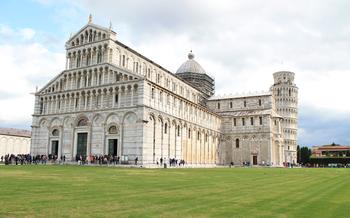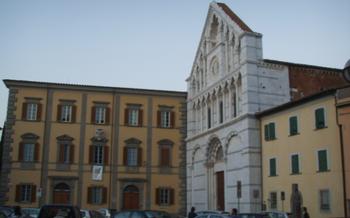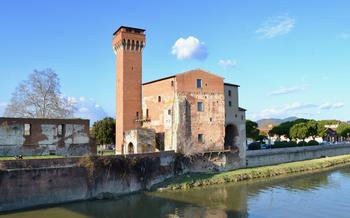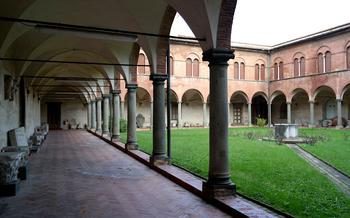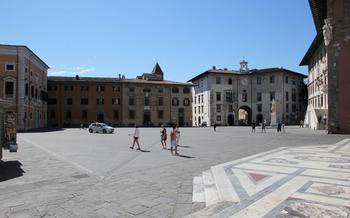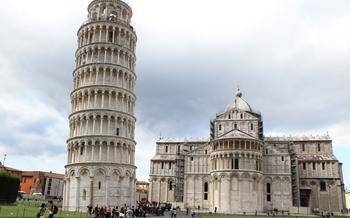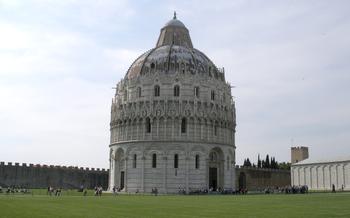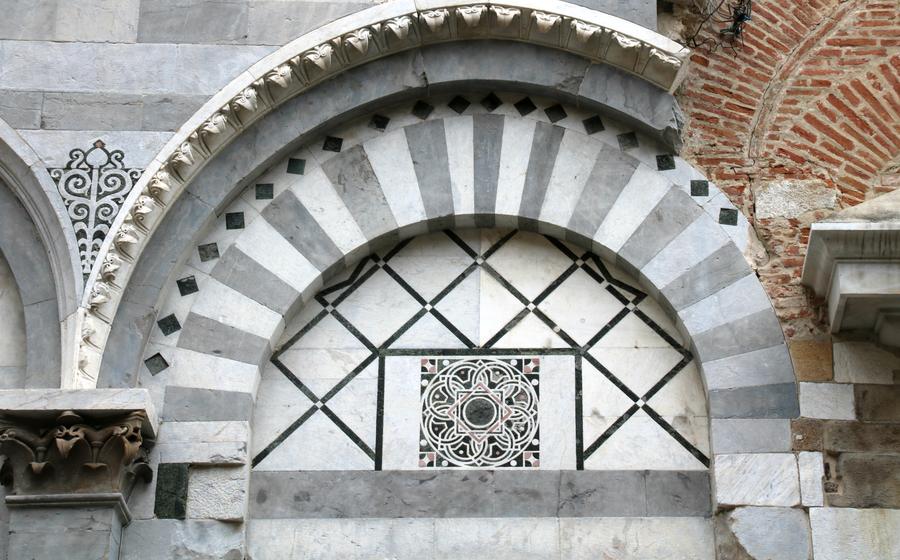
Chiesa di San Nicola
- Introduction - Chiesa di San Nicola: A Hidden Tuscan Gem
- The Masterpiece: Unveiling the Intriguing Frescoes
- Unraveling the History: A Journey Through Time
- Stepping Inside: An Immersive Experience
- A Place of Worship: Exploring the Sacred Spaces
- The Artist's Legacy: Discovering Francesco Traini
- History in Every Corner: Exploring the Church's Artifacts
- A Symbol of Faith: The Cross of San Nicola
- The Church's Place in Pisa's Art Scene
- The Church in Literature and Art: A Cultural Legacy
- A Photographic Journey: Capturing the Essence
- Practical Information: Planning Your Visit
- The Neighborhood's Charm: Exploring Pisa Beyond the Church
- Insider Tip: Unveiling the Secret Garden
Introduction - Chiesa di San Nicola: A Hidden Tuscan Gem
Nestled amidst the enchanting streets of Pisa, Italy, lies a hidden gem that often goes unnoticed by the throngs of tourists visiting the city. The Chiesa di San Nicola, a testament to the rich artistic and religious heritage of Tuscany, stands as a beacon of faith, history, and exquisite artistry. Founded in the 12th century, this humble yet awe-inspiring church houses a treasure trove of medieval frescoes that transport visitors to a realm of biblical narratives and profound symbolism. As we embark on a journey to explore this hidden gem, let us unravel the captivating stories that lie within its sacred walls.
To reach the Chiesa di San Nicola, take a picturesque stroll along the cobbled streets of Pisa, crossing the fabled Ponte di Mezzo, which spans the serene waters of the Arno River. A short walk from the iconic Piazza dei Miracoli, where the Leaning Tower of Pisa proudly stands, you will find the church nestled in a tranquil corner, inviting you to discover its hidden wonders.
The Masterpiece: Unveiling the Intriguing Frescoes
In the heart of the Chiesa di San Nicola, a masterpiece awaits visitors - a series of mesmerizing frescoes that adorn the walls and ceiling, captivating the senses with their vibrant colors and intricate details. Created by the talented hand of Francesco Traini, these frescoes rank among the finest examples of Tuscan art from the 14th century.
The frescoes narrate biblical stories with remarkable clarity and emotion, immersing viewers in the drama and spirituality of each scene. From the Annunciation to the Crucifixion and Resurrection of Christ, Traini's brushstrokes bring to life the key moments from the Gospel, offering a visual feast that transports visitors back in time.
Beyond their narrative prowess, these frescoes are renowned for their unique artistic style, characterized by a harmonious blend of realism and symbolism. Traini's meticulous attention to detail breathes life into his figures, capturing their expressions, emotions, and gestures with remarkable accuracy. At the same time, his use of symbolism adds depth and meaning to the scenes, inviting viewers to contemplate the underlying spiritual messages.
Each fresco is a testament to Traini's mastery of color and composition, creating a cohesive visual masterpiece that adorns the church's interior. The vibrant blues, reds, and golds seem to dance across the walls, illuminating the sacred space with an ethereal glow. The carefully arranged figures and the intricate backgrounds create a sense of harmony and balance, drawing viewers' eyes to the central narratives.
The frescoes in the Chiesa di San Nicola are not merely decorative elements but profound works of art that speak to the viewer's soul. They invite contemplation, inspire devotion, and offer a glimpse into the rich artistic and spiritual heritage of Pisa.
Unraveling the History: A Journey Through Time
The construction of the Chiesa di San Nicola began in the 12th century, showcasing a blend of Romanesque and Gothic architectural styles. Its sturdy stone facade features intricate carvings and arched doorways that hint at the artistic treasures within. Step inside, and you'll be greeted by a harmonious fusion of architectural elements, including vaulted ceilings supported by elegant columns, delicate stained glass windows filtering in colorful light, and an awe-inspiring altar adorned with intricate carvings.
Throughout its existence, the church has played a pivotal role in Pisa's religious and cultural fabric. As a place of worship, it hosted countless religious ceremonies, baptisms, weddings, and funerals, bearing witness to the spiritual journey of generations of Pisan faithful. Its location in the heart of the city, close to the bustling Piazza dei Miracoli, made it a natural gathering place for the community, fostering a sense of unity and belonging.
Stories and legends intertwined with the history of the Chiesa di San Nicola add to its mystical charm. One such tale speaks of a miraculous event that occurred during its construction. As the builders struggled to raise the heavy bell tower, they were visited by an angel who assisted them in their task, ensuring the successful completion of the church.
Stepping Inside: An Immersive Experience
Stepping inside the Chiesa di San Nicola is like stepping into a bygone era. The church's interior exudes an atmosphere of tranquility and reverence, inviting visitors to pause and reflect. The soft light filtering through the stained-glass windows casts a warm glow on the frescoes, creating a mesmerizing effect.
Notable features of the interior include the intricately carved wooden altar, the elegantly ornamented pulpit, and the vibrant stained-glass windows. The altar, a masterpiece of craftsmanship, features intricate carvings depicting scenes from the life of Christ. The pulpit, adorned with bas-reliefs of saints and angels, is a testament to the skill of medieval artisans. The stained-glass windows, bathed in sunlight, add a touch of ethereal beauty to the church's ambiance.
A visit to the Chiesa di San Nicola is a multisensory experience. The faint scent of incense lingers in the air, creating a sense of sacredness. The sound of footsteps on the stone floor echoes through the vast space, adding to the awe-inspiring atmosphere. The church's acoustics are such that even a whisper seems to carry a mystical quality.
A Place of Worship: Exploring the Sacred Spaces
The Chiesa di San Nicola holds profound significance as a spiritual center in Pisa. Devotees and travelers alike are drawn to its sacred spaces, where the air is imbued with a sense of devotion and tranquility. The church regularly hosts religious services, including masses, prayers, and hymns, creating an atmosphere of deep reverence and community among the faithful.
Beyond its spiritual significance, the church also serves as a venue for cultural and educational events, fostering a dialogue between art and faith. Visitors may encounter exhibitions, lectures, or concerts that explore the church's history, architecture, and artworks, providing a deeper understanding of its multifaceted role in Pisan society.
The Artist's Legacy: Discovering Francesco Traini
Francesco Traini was a 14th-century Italian painter who called Pisa his home. He is renowned for his mastery of the Gothic style and the enchanting frescoes that adorn the walls of the Chiesa di San Nicola. Traini's artistic technique is evident in his meticulous attention to detail, vibrant use of colors, and the emotive expressions he captured in his subjects.
While much of Traini's life remains shrouded in mystery, his works offer glimpses into his artistic brilliance. Beyond the frescoes in San Nicola, Traini's contributions to the art world include masterful altarpieces and panel paintings. His work, "The Triumph of Death," a poignant depiction of the futility of worldly pursuits, stands as a testament to his profound understanding of human nature.
What sets Traini's frescoes in San Nicola apart is their narrative complexity and theological depth. His ability to capture the essence of biblical stories and convey their spiritual significance through art is truly remarkable. Each fresco is a visual sermon, inviting viewers to contemplate the mysteries of faith and the human condition.
Through his artistic genius, Traini left an indelible mark on the artistic landscape of Pisa. His creative vision continues to inspire and captivate art enthusiasts to this day, making the Chiesa di San Nicola a must-visit destination for anyone seeking to appreciate the profound beauty of Italian Gothic art.
History in Every Corner: Exploring the Church's Artifacts
The Chiesa di San Nicola is a treasure trove of significant relics and artifacts that offer a glimpse into its rich past. Among the most notable is a beautifully preserved wooden crucifix, believed to date back to the 13th century. This poignant depiction of Christ's crucifixion evokes a sense of reverence and invites visitors to contemplate the profound sacrifices made in the name of faith.
Another captivating artifact is a collection of ancient manuscripts, carefully preserved within the church's archive. These handwritten texts, adorned with intricate illuminations, provide a glimpse into the intellectual and spiritual life of Pisa during the Middle Ages. Visitors can marvel at the meticulous craftsmanship and the depth of knowledge contained within these timeworn pages.
Finally, the church houses a series of intriguing stone fragments, believed to be remnants of an earlier structure that once stood on the same site. These fragments, adorned with delicate carvings and inscriptions, offer tantalizing clues about the church's origins and the architectural evolution of Pisa over the centuries.
A Symbol of Faith: The Cross of San Nicola
In the heart of the Chiesa di San Nicola, a striking symbol of faith captures the attention of visitors—the Cross of San Nicola. Carved with intricate detail and adorned with precious gemstones, this majestic cross stands as a testament to the church's devotion and the enduring power of Christianity.
History and legend intertwine around this venerable cross. According to local lore, it was crafted by skilled artisans in the 13th century, commissioned by a wealthy merchant who sought to honor the divine protection he had received during a perilous sea voyage. Another tale suggests that the cross was a gift from the Knights Templar, a powerful military order that played a significant role in the Crusades.
Whatever its origins, the cross has become an integral part of the church's identity. It is displayed prominently on the altar, serving as a focal point for prayer and contemplation. Believers seek solace and guidance from its presence, offering their petitions and prayers to the heavens.
The cross's design is a marvel of craftsmanship. Intricate carvings depict scenes from the Bible, narrating the life and teachings of Jesus Christ. Precious gemstones, such as rubies and sapphires, adorn its surface, reflecting the light and casting a radiant glow within the church.
The Cross of San Nicola is not merely an ornament; it is a symbol of hope, redemption, and eternal life. For centuries, it has stood as a reminder of the enduring power of faith, inspiring generations of believers to seek solace and guidance within the church's sacred walls.
The Church's Place in Pisa's Art Scene
The Chiesa di San Nicola holds a significant place in the development of Pisan art. Its frescoes, particularly those by Francesco Traini, are considered masterpieces of the Gothic period and have influenced generations of artists. The church's unique artistic style, characterized by its vibrant colors, expressive figures, and intricate details, has left an indelible mark on Pisan art and architecture.
The frescoes in San Nicola have served as a source of inspiration for numerous other artists in Pisa. The influence of Traini's work can be seen in the paintings and frescoes of other Pisan churches and public buildings. The church has also played a role in the development of Pisan sculpture, with many of the city's most notable sculptors having been influenced by the figures and forms depicted in the frescoes.
A comparison of San Nicola's frescoes to other notable works in Pisa reveals the church's unique contribution to Pisan art. While the frescoes in the nearby Camposanto Monumentale are more famous and elaborate, those in San Nicola are more intimate and personal. They offer a glimpse into the lives of ordinary people and their relationship with the divine, making them a valuable and distinctive part of Pisan artistic heritage.
The Church in Literature and Art: A Cultural Legacy
The Chiesa di San Nicola holds a significant place in Pisa's cultural heritage, immortalized in various forms of art and literature. Italian writer and poet Gabriele D'Annunzio, known for his profound appreciation of beauty and aesthetics, dedicated a poem to the church, capturing its ethereal essence and the captivating allure of its frescoes. The church's unique architectural features and awe-inspiring artwork have also served as inspiration for renowned artists, who have depicted the edifice and its surroundings in their paintings and drawings, contributing to its enduring cultural legacy.
The frescoes themselves have been meticulously documented and studied by art historians and scholars, who have delved into their symbolism, iconography, and artistic techniques. These experts have shed light on the deep religious and cultural significance embedded within the artwork, providing valuable insights into the minds of the medieval artists who created them.
Moreover, the church's captivating presence has extended beyond the confines of Pisa, reaching international audiences through literature and film. In Dan Brown's bestselling novel "Inferno," the church plays a pivotal role, drawing readers into a thrilling mystery that unfolds within its sacred walls. Similarly, the church has graced the silver screen, appearing in several films, including "The Portrait of a Lady" and "Tea with Mussolini," showcasing its architectural grandeur and artistic splendor to a global audience.
The Chiesa di San Nicola, with its rich history, stunning frescoes, and profound cultural impact, stands as a testament to the enduring power of art and faith. Its legacy continues to inspire and captivate visitors from around the world, leaving an indelible mark on the hearts and minds of those who encounter its beauty.
A Photographic Journey: Capturing the Essence
The Chiesa di San Nicola is a treasure trove for photography enthusiasts. The intricate frescoes that adorn the walls and ceiling provide endless opportunities to capture the essence of this hidden gem. To fully embrace the photographic experience, here are some tips:
-
Wide-Angle Lens: A wide-angle lens is essential for capturing the frescoes' grandeur and the overall ambiance of the church. Experiment with different angles to showcase the scale and perspective of the artwork.
-
Natural Light: Natural light flooding through the windows creates a soft and ethereal glow that enhances the beauty of the frescoes. Plan your visit around sunrise or sunset to take advantage of the warm, golden light.
-
Tripod Stability: A sturdy tripod will ensure sharp and clear shots, especially when capturing details of the frescoes. This will help you avoid camera shake and maintain focus on the intricate details.
-
Composition and Perspective: Experiment with different compositions and perspectives to create visually compelling images. Try shooting from various angles, including low and high vantage points, to add depth and interest to your shots.
-
Capture the Ambiance: Don't just focus on the frescoes; take some time to capture the ambiance of the church. Include elements like the altar, pulpit, and stained glass windows to provide context and convey the spiritual essence of the space.
Practical Information: Planning Your Visit
To fully appreciate the beauty of Chiesa di San Nicola, it's wise to plan your visit. Opening hours typically range from 9 am to 6 pm, with possible variations depending on the season or special events. The entrance fee is generally minimal, allowing visitors to explore this hidden gem without breaking the bank.
Guided tours are available upon request, providing insightful commentary on the church's history, architecture, and artwork. These tours are especially recommended for those seeking a deeper understanding of the church's significance.
When visiting a religious site, appropriate attire is essential. While strict dress codes may not be enforced, showing respect through modest clothing is advisable. Visitors are also encouraged to maintain a respectful demeanor, mindful of the church's sacred nature.
Accessibility for visitors with disabilities is a priority at Chiesa di San Nicola. Ramps and elevators have been thoughtfully incorporated to ensure that everyone can conveniently access the church's interior. Visitors with specific accessibility needs are encouraged to inquire beforehand to ensure a smooth and enjoyable experience.
The Neighborhood's Charm: Exploring Pisa Beyond the Church
Stepping out of the Chiesa di San Nicola, you'll find yourself immersed in the vibrant neighborhood that encapsulates Pisa's essence. Explore the charming streets lined with enticing local restaurants, inviting cafes, and unique shops offering an array of Tuscan delights and artisan crafts. Take a break from your cultural exploration and savor the flavors of authentic Italian cuisine at one of the many family-run restaurants, indulging in fresh pasta, wood-fired pizzas, and delectable desserts.
Don't miss the cultural attractions and events that bring this neighborhood to life. Visit the nearby museums, galleries, and theaters to delve deeper into Pisa's rich history and artistic heritage. Throughout the year, the neighborhood hosts vibrant festivals, street fairs, and traditional celebrations that showcase the city's lively spirit. Embrace the opportunity to mingle with locals, immerse yourself in the infectious energy, and create lasting memories of your Tuscan adventure.
To fully experience the neighborhood's charm, consider extending your stay in Pisa. Immerse yourself in the city's tranquil ambiance, stroll along the picturesque riverfront, and discover hidden gems tucked away in its medieval streets. Pisa offers a treasure trove of cultural experiences, from its iconic Leaning Tower to the serene Botanical Garden and the Museo Nazionale di San Matteo. Embrace the opportunity to explore this captivating city at your own pace, uncovering its secrets and immersing yourself in its timeless allure.
Insider Tip: Unveiling the Secret Garden
Tucked away behind the Chiesa di San Nicola lies a hidden gem that many visitors miss: a tranquil garden that offers a serene escape from the bustling city. This enchanting sanctuary, known as the Giardino Segreto, is a true oasis of peace and tranquility.
Step through an unassuming doorway and be transported into a world of verdant beauty. The garden is a tapestry of vibrant colors and fragrant blooms, with meticulously manicured lawns, towering trees, and trickling fountains. Stroll along the winding paths and discover hidden nooks and secluded corners that invite contemplation and relaxation.
The garden's history is intertwined with that of the church itself. It was once a private retreat for the monks who resided here, a place where they could find solace and communion with nature. Today, it remains a place of tranquility, a sanctuary for weary souls seeking respite from the demands of modern life.
To access the secret garden, visitors should inquire at the church office. Guided tours are available upon request, providing insights into the garden's history and its unique botanical features.
Whether you seek a moment of solitude, a chance to connect with nature, or simply a respite from the hustle and bustle of Pisa, the Giardino Segreto is a hidden gem that should not be missed.
